On the Road is a weekday feature spotlighting reader photo submissions.
From the exotic to the familiar, whether you’re traveling or in your own backyard, we would love to see the world through your eyes.
Ex-lurker
Many (many) years ago I was a master falconer. “Master” is a bit misleading; it’s just a matter of being licensed and flying enough birds. I don’t have a smidgen of the knowledge of people who have been doing it for 30 years or more.
Anyway, a few years ago I decided to get back into the sport, if only to be a spectator. I joined the California Hawking Club and I’ve been to a few of their meets. I spent an inordinate amount of time in my late teens and early twenties just wandering around southern Idaho looking at raptor nests and (in the winter) trapping birds. (I just let them go after checking they were healthy.) I’ve been back in southern Idaho a couple of times in the last few years going to places I used to get birds. So, now I have a bunch of pictures of raptors and raptor nests that I thought people might find interesting. I don’t have the photography skills or knowledge of Albatrossity, but I do have the advantage that most of my photos are of birds sitting still.
Some notes on nomenclature. Since falconry is an ancient sport, there are words commonly used by falconers which have fallen into disuse in regular circles, or have a different meaning outside of falconry.
In falconry lingo, a “falcon” refers to a female of the genus Falco, in particular Peregrines; the males are tiercels (supposedly so-called because they are about 1/3 smaller than the females). Because it’s somewhat clumsy to refer to, say, a “falcon gyrfalcon,” females are often referred to as “females” rather than as “falcons.” And tiercel is often applied to any male raptor.
Birds are also described with different terms for when they were taken from the wild (or, these days, from a breeding program). The three general categories are (1) eyasses (taken from the nest or soon after they are fledged), (2) passagers or passage birds, taken in the fall of their first year and through the winter before their first molt and (3) haggards, which are adult birds taken after their first molt. Birds become progressively more difficult to “man” (become tame enough to be ready to train) from eyasses to haggards, but they’re easier to train to hunt as they get older. These age designations follow the bird throughout its life. A bird that has molted in captivity is referred to as “intermewed,” so a 5-year-old bird taken from the nest is an “intermewed eyass.”
There have been two enormous changes to the sport since I flew birds. First, cheap telemetry, so you don’t lose your birds. The birds fly free, and if they don’t feel like working, they might just fly away. In the old days, you could easily lose them. I can’t describe the frustration of losing a bird you’ve spent dozens, even hundreds of hours training, but it happened often. Nowadays, you put a GPS tracker on the bird and you can see on your phone where and how fast and how high it’s been flying. (Incidentally, if a bird is lost it just goes back to the wild; they’re fine–more than once I trapped birds that somebody else had lost months previously.)
The other big change is captive breeding. Falconry was practiced for 2500 years before falconers figured out how to breed them in captivity. Falconers nowadays have access to all sorts of exotic birds that were simply unavailable when I was flying. I used to joke that I could have paid my way through college by trapping a gyrfalcon and selling it (illegally) to the Saudis, but these days you can just go online and buy one legally. There are also interesting hybrids. A lot of falconers these days like gyrfalcon/peregrine hybrids–they’re nearly as large as gyrfalcons, but they’re much less high strung; also they are easier to teach to “wait on” (circle around above the falconer’s head at anywhere from 100 to 1500 feet), which peregrines do naturally but gyrs do not.
You’ll notice some of the gyr/peregrine hybrids have very different plumage. That’s because gyrs come in three color morphs (black, grey and white), and because there is no “standard” plumage in hybrids.
So, enjoy.
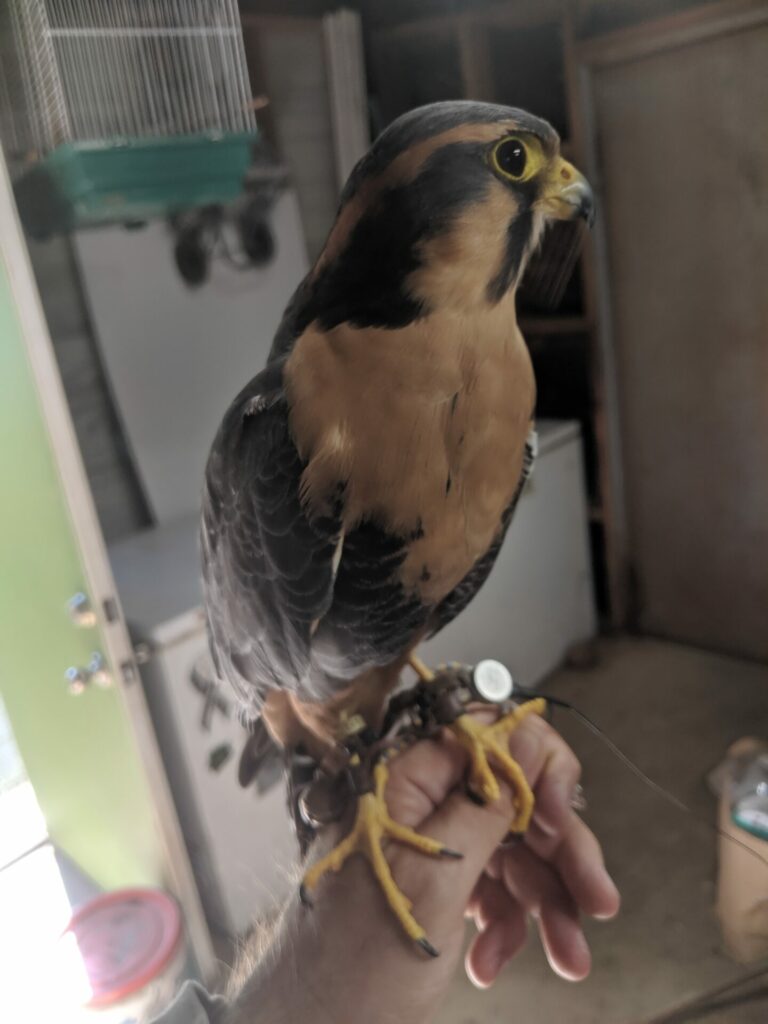
This is a tiercel Aplomado falcon (Falco femoralis). They’re occasionally found in southern Arizona and Texas, but this bird was captive bred.
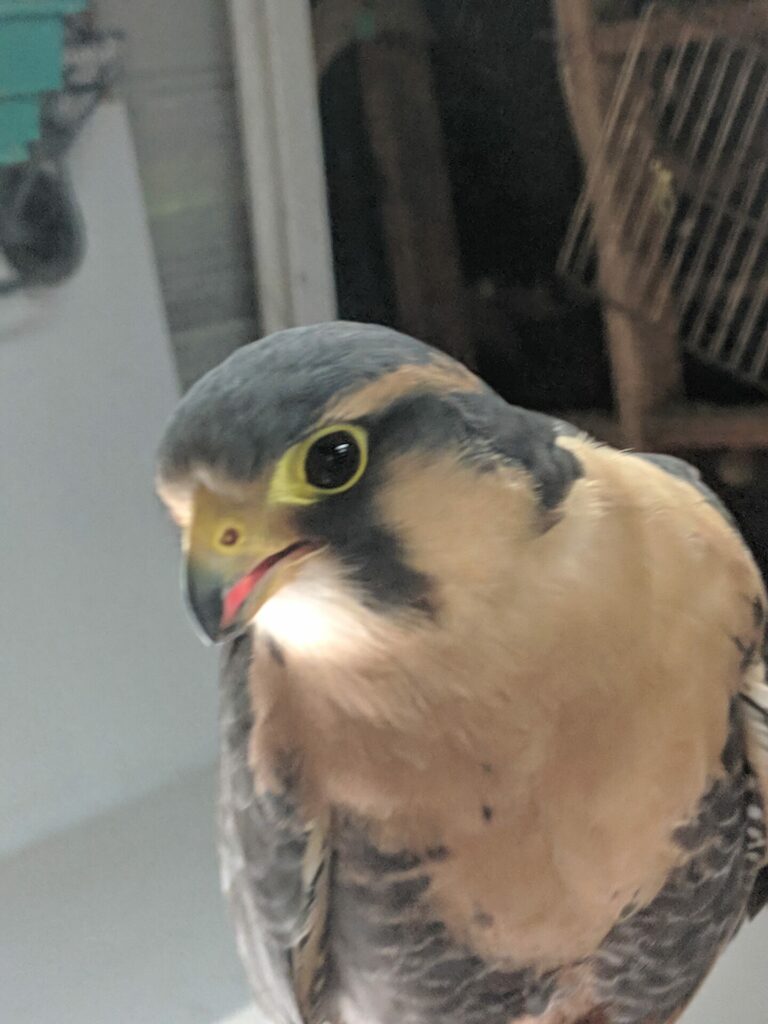
This is another view of the tiercel Aplomado
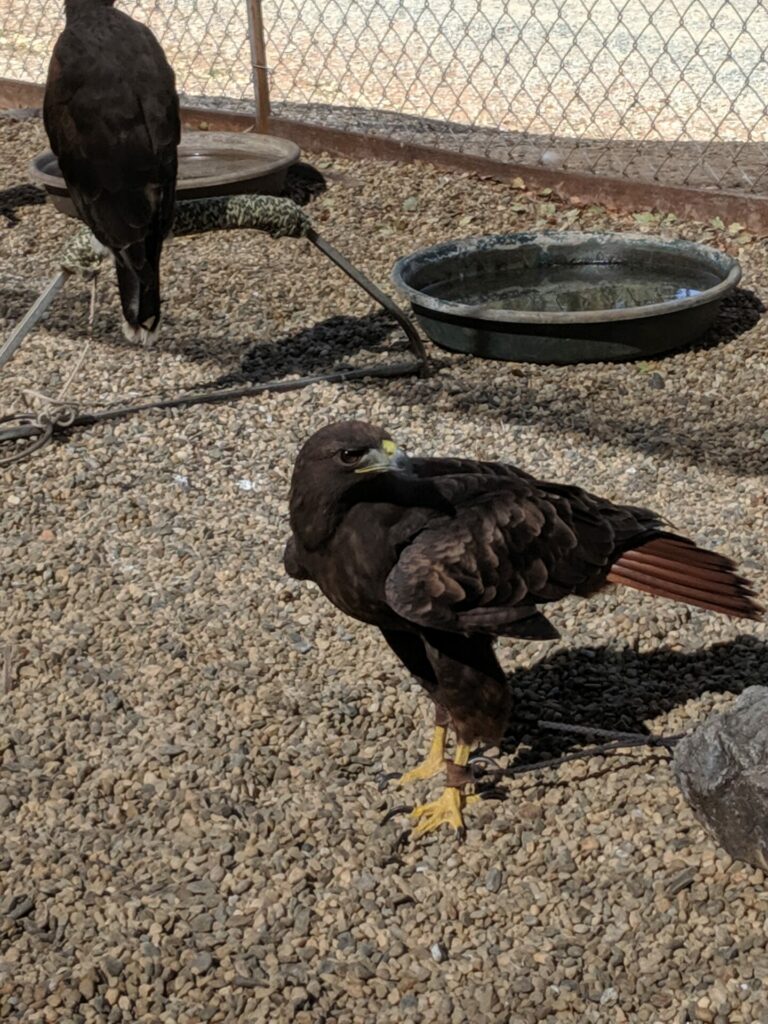
This is a dark phase female red tail (buteo jamaicensis), which is fairly rare here in California. I’ve seen them even darker in Idaho, with just a red “wash” on the tail feathers to tell you it’s a red tail.
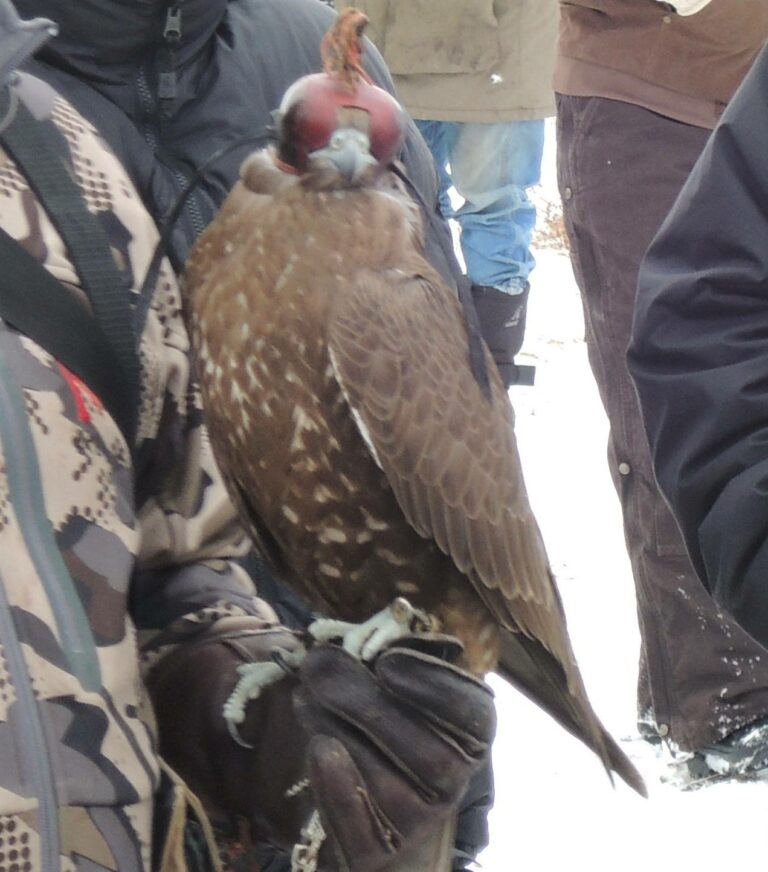
This is an eyass tiercel gyrfalcon (Falco rusticolus). This bird will molt into a black gyr. This bird is enormous for a tiercel–I would have guessed it was a falcon if somebody hadn’t told me what it was.
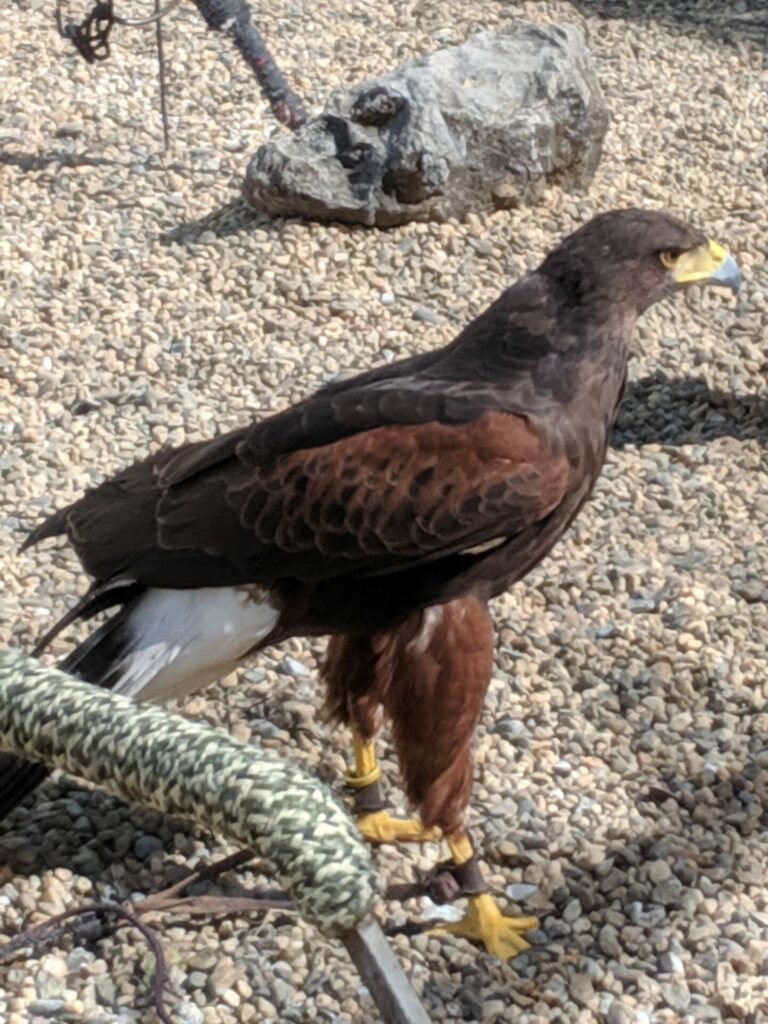
This is a female Harris hawk (Parabuteo unbicinctus). Harrises are really popular these days; they’re very mellow and usually easy to train. I had a female Harris hawk that Fish and Game confiscated from someone who had her illegally and asked me to look after. She used to play with my dog–waiting for him to fall asleep, then walking over to tweak his ear and bouncing away.
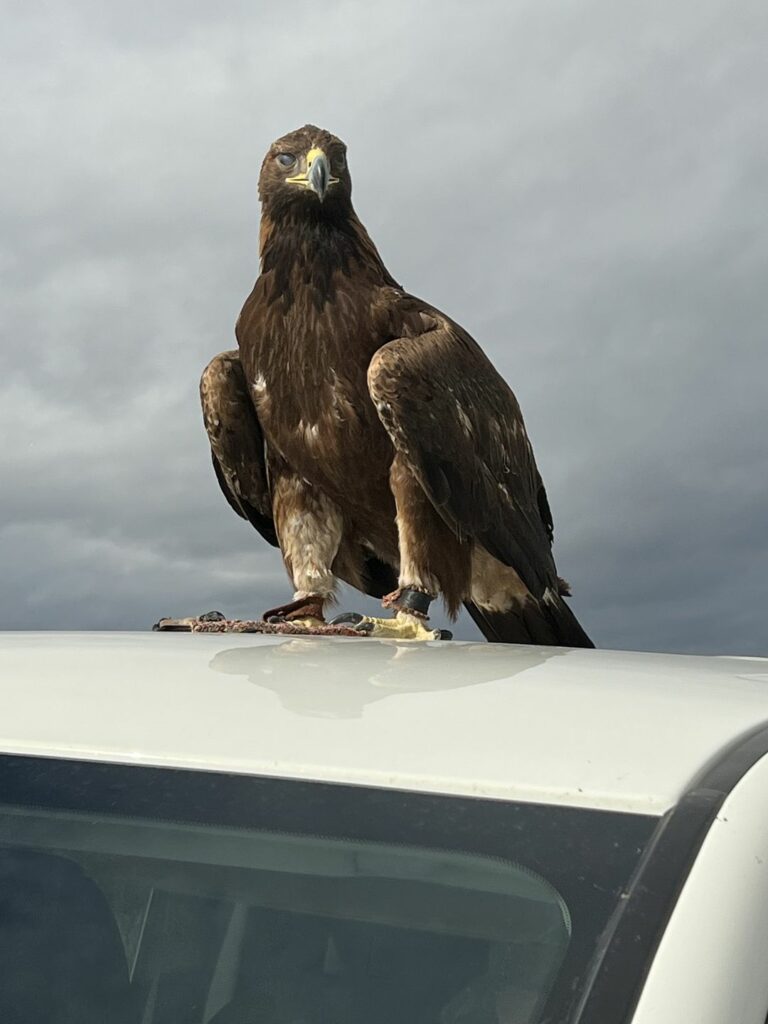
This is a better shot of the same Golden
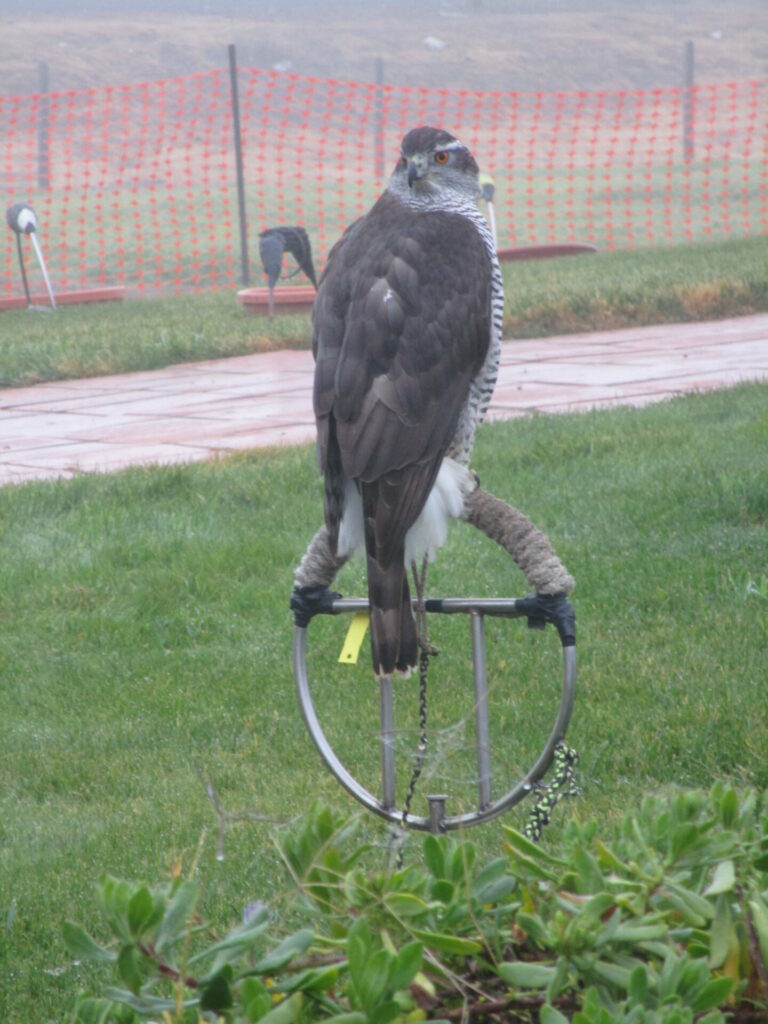
This is an intermewed eyass Northern Goshawk (Accipter gentilis). You can tell this is an adult bird by the orange color of the eyes. Let me tell you, it’s damned intimidating to be near a goshawk nest and have one of these birds come arrowing in through the trees with those mad eyes gleaming under the white eyebrow. I never went into a goshawk nest without a helmet and a thick canvas coat.
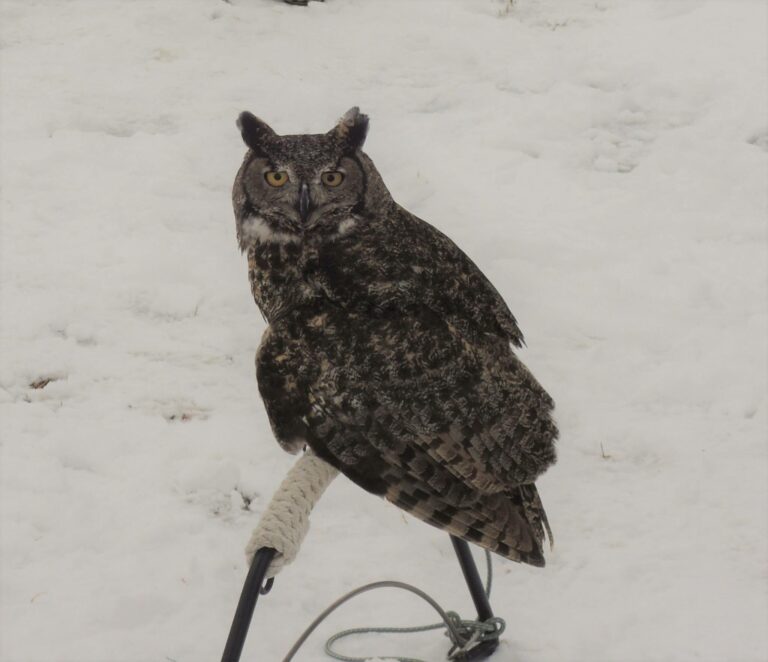
This is a male Great Horned Owl. This is the only North American owl regularly used in falconry. I rehabbed a couple of these and found them difficult to deal with and “grabby” with their feet.

AlaskaReader
I love that I regularly have visiting Peregrines in my yard in the summers.
oldster
Cool stuff!
I know the word “eyasses,” because Hamlet uses it, metaphorically, to refer to an acting troupe of children, as though he had called them “nestlings”. It’s nice to know that the word is still in use.
raven
I remember being in the upper deck at the University of Illinois football stadium when we played Air Force. That Falcon cruised right under out noses and it was spectacular! Thanks for the memory!
AlaskaReader
@oldster:I’m a fan of words,
…(still) in use and those out of use.
Eyas Originated as a Linguistic Mistake
HeartlandLiberal
What a wonderful post. I learned a lot.
These days, at 77, I live by the words of John Wooden, ” learn as if you were going to live forever, and live as if you were going to die tomorrow.”
Thanks for your words.
Betsy
When I was an English literature major, my Chaucer professor told us that a number of Toyota car models were named from falconry inspirations. As I recall, he said the Tercel, the Camry (?), and one other that I can’t recall were named for late-medieval terms in falconry. I think he connected the Avalon too, saying some marketer deep within the car company must have had a thing for ancient England.
oldster
@AlaskaReader:
Thanks, that’s fun! I had not realized that “eyass” was from niais by false division. The French word is still in (somewhat) common use as a term of contempt for a trivial innocent, like “born yesterday.”
raven
@HeartlandLiberal: A true adult educator!
Torrey
Fascinating! Thank you!
Princess
This indeed is a full service blog. Beautiful!
BellyCat
Fascinating! Thanks for sharing.
Don
More please. That was cool.
Argiope
@Princess: Yes! This was so fascinating. It would be fun to learn about other Jackal pastimes in this format.
Thanks for the beautiful pics and information!
Kristine
This was great–I learned so much. Also, gorgeous birds. I love the story of the doggy ear-tweaker.
Miki
Wow! So fascinating! Thank you!
Albatrossity
Wonderful stuff! Thanks for putting this together!
frosty
Really interesting and something I knew nothing about. Thanks for sending this to WaterGirl.
ETA: The eyes on the first falcon are huge!
Miss Bianca
So cool. Falconry fascinates me, even tho I know I have neither the patience nor the time to pursue it. Still, I have an online acquaintance who is a truly ancient falconer – been at it for over 65 years! – and I love to read what he has to say. And I have a younger acquaintance who’s gotten into it in a big way down in New Mexico – hoping to visit her and her hawks some day.
How are redtails in terms of trainability? They are very plentiful in my neck of the woods.
Mike S. (Now with a Democratic Congressperson!)
As a birder who had seen 4 Gyrfalcons flying wild here in PA ove the years, I’m glad to know captive breeding has become significant for those magnificiet birds.
And Aplomados are so damn pretty! I was thrillld to see them 2 yuears ago in Belize. Here is my on-the-road post about the Raptors at Chan Chich at Gallon Jug.
Thanks for all the great info and pics!
MoCaAce
Fascinating! I have always wanted to get into falconry and may yet do it when I am retired. We have a state falconry group and I plan on joining to learn more and attend gatherings. I have always been in love with the Northern Harrier (Circus hudsonius). I live in a marshy area and see them flying low over the marshes and fields all the time, tilting side to side and hovering over the grass as they eye their next meal. Are they a bird you see in falconry circles very often?
catclub
‘Play’ with the dog for some values of ‘play’.
J R in WV
I have seen v small hawks stooping on tiny wild game, like field mice in big local truck gardens in fall on the way home after work. It was amazing to see their methods of fencing in the captured critter with their wings against the ground!
I must say however I’m not sure how I feel about keeping these beautiful wild birds in captivity when they are so well adapted to their lives in the wild — no offense intended, we see them in the wild so often on our wooded landscape!
Thanks for sharing!
Mike S. (Now with a Democratic Congressperson!)
BTW you didn’t tell us the story of the Golden Eagle that owns the car!
Jager
There is a licensed California Falconer in Ventura County, I watched two of his birds evict the seagulls from a shopping center parking lot in Westlake Village.
Fascinating post, thank you.
The Moar You Know
When I was a kid, back in the 1970s, my violin teacher had a side gig doing bird rescue and falconry. She bought one of the little ones to the radio control plane parties that my mom used to go to.
Little bird.
She asked if I wanted to hold it, I said “of course!” So she got what I thought was an unnecessarily thick leather glove, put it on me, and told me what to do so this (I repeat) LITTLE bird would climb on my hand.
Well, that glove was the right thickness. I will never forget that, ever. That tiny bird got on my hand and clamped down with its talons and it was like a large man who did nothing but hand grip strength training had put a pair of pilers on that glove and was smashing down for all he was worth. Strong doesn’t begin to describe it. It didn’t hurt at all but I remember thinking “oh my, this is how they kill prey in the air, they just smush it!”
The larger eagle-sized group of birds, I don’t know how people handle those, I’m sure they could crush your arm bones if they wanted to.
Somehow we’ve managed not to kill them all off with DDT and related chemicals. I’m profoundly grateful for that. They are just magnificent creatures. I’m always happy when I see the red tails in San Diego. Happier when I see them in my neighborhood since they keep the crows away.
Jager
@The Moar You Know:
At our old house, our spa and pond in the lower yard were always filled with wildlife, our neighborhood California Brown Hawk would show up for a drink, and everybody would shut up, and pay their respect. The hawk would drink its fill, and take a break on a branch overlooking the lower yard. Nobody made a peep until the hawk left.
Fleeting Expletive
My first ex-husband was a zoology major and ornithologist. In our last year at OU, I managed a rare jump on his sharp eyes and encyclopedic knowlege of everything, the time I spotted a pair of perigrine falcons dancing in a tree, mating. Is that redundant, “falcon” being a term for female?
This was a great read. Thank you.
CaseyL
Back when I was a zoo docent, I got to hold a very large owl (can’t remember what type) on my arm for a while. (Yes, I was gloved.) I remember how astonishingly heavy it was. And how watchful I needed to be :)
Magnificent creatures.
pieceofpeace
Thanks for the explanations and pictures. Your writing formed a curiosity of these beauties. Looking for further photos and to read more about them.
Their intensive eyes brought up the memory of the mantra from the book, Island, that had the roam-around blaring “ATTENTION!” continually as it moved from place to place.
StringOnAStick
That first photo has the bird on an ungloved hand! Amazing!
My best friend in junior high was into falconry and had a permit for a Kestral that was unreleaseable because of a wing injury. It loved grasshoppers; pull off the head, toss the gut sac, and crunch up the rest. If it didn’t like you it would toss the gut sac into you. She also had a redtail(with permit) that she was training for hunting. Being able to be close to these birds was such a gift for young me, plus I learned words I still use, like “yark”, the descriptive word for when a bird was excited about food or potential food, back of the neck feathers standing out and generally showing keen interest.
Thanks for the photos and your great stories!
BigJimSlade
Wow – very neat stuff! Thanks ex-lurker!
NutmegAgain
Fantastic, thank you. I love raptors (perhaps because I detest squirrels & rabbits???) I live in CT, right near the big river. Red tails are super common around here–I probably see them the most often. There is also a red shouldered hawk who seems to live in my neighborhood. I keep meaning to do some checking about ospreys, thinking they must nest closter to/right over the river. I used to see them in MA near the Charles river. Anyhow, please keep us posted!
Ex-lurker
I just got to my computer and see that there are a bunch of questions. I’ll try to answer them without naming the commenter, because there are too many. If this comment gets too long, I’ll start another. Anyway, here goes.
I’ve never heard the term “Camry” or anything like it connected to falconry, but there are lots of old terms no longer in use, so it’s possible.
As for the eagle–another picture explaining its presence somehow didn’t make it in. This bird showed up when I was out hawking with some folks who had two male Harris hawks and one female (Harris’s are easier than most birds to fly in “casts” (groups of multiple birds, usually two) because unlike most raptors they sometimes hunt cooperatively in family groups.) Anyway, this eagle ended up on our truck. We had to bring in the Harris hawks, because you can’t fly with an eagle nearby–it will attack anything smaller. We called around and discovered that a local falconer was “hacking her back,” which means he’d rehabbed her after an injury and was gradually getting her used to being wild again–feeding her at first, then gradually feeding less. Anyway, the hacking process wasn’t very far advanced, as the eagle should not have wanted to be near humans. Also she clearly wasn’t getting much food on her own–to a falconer she’s clearly very skinny and her crop is completely empty. When the falconer who had rehabbed her showed up, he had exactly the same kind of truck and camper shell, which explains why she thought we might feed her. We could have tried to pick her up, but (a) none of us had gloves thick enough and (b) the falconer said she was aggressive (a trait he would not have tried to eliminate, because he wanted her back in the wild).
Someone asked about the strength of their grip–yes, an eagle can at least crack bones. I knew a falconer (Morley Nelson, for whom the Morley Nelson Birds of Prey Natural Area in Idaho is named) who was showing off one of his eagles and let it sit on his ungloved wrist. She got startled and clamped down on his wrist and cracked a bone.
OK, some more answers in the next comment.
Ex-lurker
OK, some more answers: Yes, the eyes are enormous, and they’re even bigger than you think, because they’re D-shaped, so the visible part sticks out. I’ve read that an eagle could see an ant on the sidewalk from the top of a six-story building, and my own experience leads me to believe that’s true.
Someone asked about trainability of red tails. I never flew one, but I rehabbed several. They’re usually pretty easy to man, which is why they are one of the two species that apprentices can fly (kestrels are the other). The ease of training them to hunt really, really depends upon the falconer, the game and the circumstances, but they’re keen.
Another person asked if Northern Harriers are used in falconry. No. Their natural way of hunting (coursing low over marsh grass and pouncing on small animals) doesn’t lend itself to use in falconry. Also, their feet are quite small, so they don’t normally take things bigger than, say, a ground squirrel (and that would be a big kill for one)
OK, I think that’s all the questions for now. I’ll check back in later if there are more that I can answer.
way2blue
Such stately birds. Albeit my first thought looking at the first photo was—why is that hand not wearing a glove? Eesh.
Ramalama
One of the books that helped get me through the death of my dad was “H is for Hawk.” I had to try it a couple times before it took me in, engulfed me (in feathers).
Great book about a Master Hawk lady dealing with the death of her dad.
Ex-lurker
OK, one more comment, for now. A couple people have remarked that the Aplomado falcon is perching on an ungloved fist. That’s my hand. I was in a barn at a falconry center with the owner who had the bird on her gloved hand and needed to deal with something, so she asked me to hold it for a few minutes.
Longwings (falcons) don’t have the grip strength of the shortwings (accipters–goshawks, Cooper’s hawks and sharp shinned hawks) or broad wings (buteos and parabuteos–in North America, generally redtails, Ferruginous hawks and Harris hawks)
Those talons are, however, sharp and if the bird was startled or upset, he could have driven a talon into my hand (and you do not want to have a bird inject bacteria from its dirty talons into you). But the bird was very mellow and we were indoors where it was unlikely to be startled, so it was very unlikely that I would have been hurt.
TriassicSands
Twice, while rock climbing, I’ve had falcons dive at me. The first time I was climbing a hand crack on a blank, slightly overhanging wall, when both adults came screaming down at me from above. The angle of the rock made it difficult for them to actually strike me with their outstretched talons. At the time, no one knew there was a nesting pair on this rock formation (Cynical Pinnacle) and after returning home, I called the state wildlife bureau and reported the “sighting.” They were overjoyed, because there were then only five known nesting pairs in Colorado. That made six. That was before the ban on DDT had resulted in the resurgence of several species. That resulted in annual closures of the Pinnacle during breeding season.
The second time was on Devil’s Tower and that time it was a lone prairie falcon. Just as I was about to reach a ledge, I heard the screeching behind me. It was known that there were prairie falcons nesting on the opposite side of the tower, but there was no closure where we were climbing. The ledge was quite a surprise — it was covered in bloody bird and small mammal parts stripped of flesh — apparently the falcons dining room. I was able to run across the ledge and jump into a large chimney. We successfully abandoned the climb without losing any blood. Previously, a climber on the other side of the tower had evidently been injured when a falcon struck him in the head with his talons doing some real damage.
It was truly exciting to see those amazing birds in action, but less than ideal when I was the target. The peregrines came directly at me from above, straight down the cliff face, and the whoosh they made as they passed a few feet behind me was a bit disconcerting. They are fast!
In BC (Haida Gwaii), while sea kayaking, I watched a peregrine falcon hunt and kill an ancient murrelet. It was extraordinary to watch. The falcon swooped at the murrelet bobbing on the water’s surface several times, each time causing it to dive. Finally, on its fourth pass the murrelet chose to fly, sealing its fate. The falcon made a phenomenal turn and smashed into the murrelet in mid-air, creating an audible “whoof” a small cloud of feathers, and the abrupt plummeting of the stunned (or dead) prey to the beach below. The falcon landed and began to feed. I felt very sorry for the murrelet, but that is way in the natural world.
Doc H
Greetings from another falconer! This is Clovis and me on our way west last November accompanied by Maisie the adventureteckel. No duck season for us – thanks HPAI* – we’re headed back to ME for the warmer months. I’m going to try to pull a male gos this summer for quail & cottontail, just in case waterfowl are still a no-go.
*highly pathogenic avian influenza
tybee
great pics from both. and someone has an interest in trains.
Doc H
@tybee:
*grin* Busted!
dp
@Ramalama: You beat me to it. Anyone interested in falconry should definitely read this book.